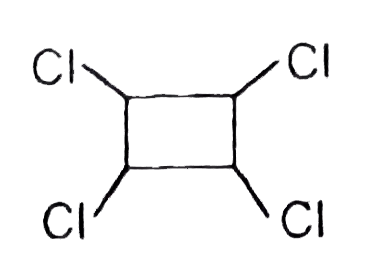Total number of stereoisomers of the compound 1-bromo-3-chlorocyclobutane is:
0
1
2
3
The correct Answer is:C
To determine the total number of stereoisomers for the compound 1-bromo-3-chlorocyclobutane, we will follow these steps:
Step 1: Identify the structure of 1-bromo-3-chlorocyclobutane
1-bromo-3-chlorocyclobutane is a cyclic compound with a four-membered ring. The bromine (Br) is attached to the first carbon, and the chlorine (Cl) is attached to the third carbon of the cyclobutane ring.
Step 2: Determine the presence of chiral centers
A chiral center is a carbon atom that is attached to four different substituents. In 1-bromo-3-chlorocyclobutane, we need to analyze the carbon atoms:
- The first carbon (C1) has Br, H, and two other carbons (C2 and C4) attached, making it a chiral center.
- The third carbon (C3) has Cl, H, and two other carbons (C2 and C4) attached, making it another chiral center.
Step 3: Count the stereoisomers
For a compound with 'n' chiral centers, the maximum number of stereoisomers is given by the formula 2n.
- Here, we have 2 chiral centers (C1 and C3).
- Therefore, the maximum number of stereoisomers is 22=4.
Step 4: Analyze the symmetry
However, we must consider the symmetry of the molecule:
- The compound has a plane of symmetry due to the arrangement of the substituents (Br and Cl) and the ring structure.
- This symmetry reduces the number of unique stereoisomers.
Step 5: Determine the final count of stereoisomers
After analyzing the symmetry, we find that:
- There are 2 unique stereoisomers for 1-bromo-3-chlorocyclobutane due to the presence of the plane of symmetry.
Conclusion
The total number of stereoisomers for 1-bromo-3-chlorocyclobutane is 2.
1-bromo-3-chlorocyclobutane is a cyclic compound with a four-membered ring. The bromine (Br) is attached to the first carbon, and the chlorine (Cl) is attached to the third carbon of the cyclobutane ring.
A chiral center is a carbon atom that is attached to four different substituents. In 1-bromo-3-chlorocyclobutane, we need to analyze the carbon atoms:
- The first carbon (C1) has Br, H, and two other carbons (C2 and C4) attached, making it a chiral center.
- The third carbon (C3) has Cl, H, and two other carbons (C2 and C4) attached, making it another chiral center.
For a compound with 'n' chiral centers, the maximum number of stereoisomers is given by the formula 2n.
- Here, we have 2 chiral centers (C1 and C3).
- Therefore, the maximum number of stereoisomers is 22=4.
However, we must consider the symmetry of the molecule:
- The compound has a plane of symmetry due to the arrangement of the substituents (Br and Cl) and the ring structure.
- This symmetry reduces the number of unique stereoisomers.
After analyzing the symmetry, we find that:
- There are 2 unique stereoisomers for 1-bromo-3-chlorocyclobutane due to the presence of the plane of symmetry.
The total number of stereoisomers for 1-bromo-3-chlorocyclobutane is 2.
Similar Questions
Knowledge Check
- Question 1 - Select One
Total number of stereoisomers of the compound 1, 4-dichlorocyclohexane is :
A0B1C2D3 - Question 2 - Select One
Total number of stereoisomers of the compound
2, 4-dichloroheptane are :A2B3C4D6 - Question 3 - Select One
Total number of stereoisomers of the compound 2-4-dichloroheptane is:
A0B1C2D3
The total number of stereoisomers for (A) is :
View SolutionTotal number of stereoisomers of truxillic acid are :
View SolutionDraw the structures of the following compounds:
1-bromo-3-chlorocyclohexaneView SolutionTotal number of stereoisomers of the 1,3 dichlorocyclohexane is:
View Solution
Total number of stereoisomers of product (B) will be:View Solution



